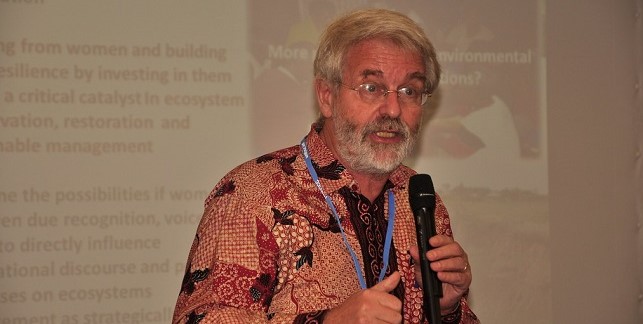The compaction of soils when natural forests are converted to agriculture hides actual carbon losses, if internationally agreed accounting methods are used. Compaction means more soil is included in a sample of the 0–30 cm layers, as the methods prescribe.

This is the conclusion of a study of soils across a wide range of land uses in six different landscapes in Indonesia, co-authored by World Agroforestry (ICRAF) scientists. The results have implications for the way policies for climate-change mitigation involving agriculture are monitored.
“The results also show that the advantages are underestimated of certain forms of agroforestry that don’t compact soil,” said World Agroforestry scientist, Meine Van Noordwijk.
The study, “Soil carbon stocks in Indonesian (agro) forest transitions: compaction conceals lower carbon concentrations in standard accounting”, was published in the journal Agriculture, Ecosystems and Environment.
“Changes in soil carbon can be quantified as concentration (the amount of carbon per unit dry soil) or by combining this with the amount of soil per standard volume of soil as carbon stock,”’ said Prof Kurniatun Hairiah from Brawijaya University in Malang, Indonesia, who is the lead author of the study. “The first shows a bigger response but the second is the agreed standard.”
Compared to the conditions in natural forests, carbon concentration in soil decreases by 8–20% in degraded forests or oil-palm plantations and by more than 40% in treeless, tilled, open-field agriculture, the study found. Simple agroforestry and monocultural crops showed values between these percentages, with a 25–30% loss in organic carbon.
However, the compaction of the topsoil that happens when land is used to grow crops means that calculated carbon stocks can even be higher than in natural forests with their spongy soil.
This means that the loss of soil carbon is currently underestimated in current accounting, the researchers conclude.
“The findings are important because policy makers need to understand the drivers of the decline of soil carbon so as to make the right decisions on how to counter it, for example, with the right agricultural policies,” said van Noordwijk.
The study noted that agroforestry practices with high density of trees and soil cover can provide conditions that are closer to natural forests and, thus, such soils lose considerably less carbon than those under intensive agriculture.
Agroforestry systems with leaf-litter layers that protect the soil’s surface and have sufficient fine root turnover to maintain soil carbon are superior to open-field agriculture when it comes to carbon storage. Such soils also have a better buffering function for water and nutrients and are less exposed to climate variability. This correlation could be harnessed to devise even better incentives for agroforestry practices, the authors argue.
The study was conducted in Indonesia because the diversity of soil types, high stocks of soil carbon and a wide range of agroforestry practices could provide insights of global relevance. The 617 samples were taken in 0–30 cm depth across eight land-use types in six locations in Jambi and Lampung provinces in Sumatra; in central Kalimantan; in eastern Java and in central and south-eastern Sulawesi.
Reliable data on changes in the storage of soil carbon related to tree cover – from natural forest, from various forms of managed forestry and from agroforestry – are also needed for the Intergovernmental Panel on Climate Change’s (IPCC) accounting of national carbon stocks, the researchers write.
“The IPCC should consider refinement in their accounting method, especially now that increased storage of soil carbon has become part of the global agenda,” said Peter Minang, leading climate-change researcher at World Agroforestry but not directly involved in the study.
